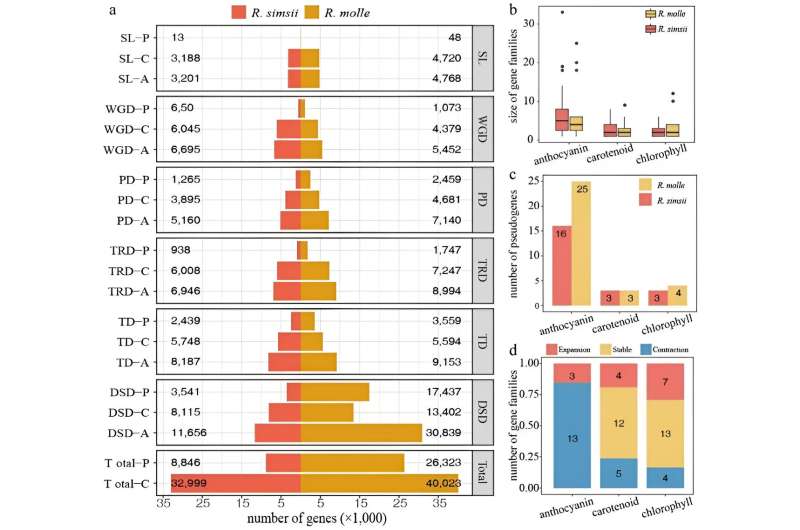This article has been reviewed according to Science X's editorial process and policies. Editors have highlighted the following attributes while ensuring the content's credibility:
fact-checked
trusted source
proofread
Scientists explore the genetic foundations of Rhododendron flower color diversity

A research team has made strides in uncovering the genetic foundations of flower color variation within the Rhododendron genus. The team's review summarizes recent advancements in phylogenetic reconstruction, genome sequencing of various Rhododendron species, and delineating metabolic pathways responsible for pigment synthesis, spotlighting the crucial structural and regulatory genes.
Discussions on gene duplications and losses further illuminate the pathways toward color diversification. By leveraging multi-omics approaches and analyzing gene co-expression networks, the researchers aim to clarify the intricate gene regulatory mechanisms.
These insights lay the groundwork for future explorations into the evolution of flower color diversity in Rhododendron and open new avenues for breeding programs focused on developing novel cultivars with specific floral characteristics.
The genus Rhododendron, is a key area of interest in ornamental plant research, due to its vast diversity of flower colors and status as one of the most prolific groups of woody plants.
A study published in Ornamental Plant Research provides support for breeding endeavors aimed at harnessing the genetics of flower coloration and developing novel cultivars that exhibit desired floral traits.
The review elucidates the rich tapestry of species diversification within the genus Rhododendron, spotlighting its status as a horticultural jewel due to its diverse flower colors and its distinction as the northern hemisphere's largest woody plant genus. Tracing back to Linnaeus's initial classification, it reveals how the genus has grown to encompass about 1,000 species, undergoing significant taxonomic evolution and refinement through the ages.
Recent phylogenetic reconstructions leveraging 3,437 orthologous nuclear genes from 200 species provide a robust, genome-level insight into the genus's lineage, identifying five subgenera and resolving long-standing taxonomic ambiguities.
This foundational work, augmented by cutting-edge molecular data, has set the stage for in-depth analyses of the genetic underpinnings of flower color diversification. It highlights the pivotal roles of gene duplications, losses, and the complex regulatory networks orchestrating pigment synthesis, as unraveled through multi-omics approaches.
As the review navigates through the challenges and opportunities presented by advanced genomic sequencing, it underscores the immense potential these insights hold for breeding novel Rhododendron cultivars, enriching the horticultural palette with new shades and hues.
According to the study's lead researcher, Prof. Shuai Nie, "This synthesis of current knowledge provides a foundation for future research on the evolution of flower color diversity within the Rhododendron lineage. Ultimately, these discoveries will support breeding endeavors aimed at harnessing the genetics of flower coloration and developing novel cultivars that exhibit desired floral traits."
This study not only improves our knowledge of Rhododendron's evolution and genetics, but also promotes the development of cultivars with enhanced ornamental value, shaping the future of plant breeding and biotechnology.
More information: Shuai Nie et al, Progress in phylogenetics, multi-omics and flower coloration studies in Rhododendron, Ornamental Plant Research (2024). DOI: 10.48130/opr-0024-0001
Provided by Chinese Academy of Sciences





















